Tips For Planning a Backyard Orchard
and Growing Fruit Trees
As more suburbanites turn their attention to urban gardening, people are also looking at perennials. "Backyard orchard" is a term that is catching on. And like so many others, you too might be ready to plant your first fruit tree. If you still have reservations, be sure to read my earlier article about overcoming common barriers to growing fruit trees. At this point though, we're going to assume that you're on board and ready to dig in!
This article series will help you to examine the benefits and functions served by fruit trees. We'll help you to evaluate what selections are best for your site. What options work best in a small urban space? How can you care for your trees? What should you do for pruning or for pest management? We'll answer these questions and also share some tips to maximize your success.
- Benefits & Functions of Fruit Trees
- Environmental Benefits of Vegetation
- Property Enhancement Through Trees
- How Plants Enhance the Soil
- Personal Benefits from Fruit Trees
- Fruit Tree, Vine & Shrub Selection
- How to Decide Which Fruit Tree, Vine or Shrub to Grow
- General Planting Prerequisites
Benefits & Functions of Fruit Trees
Before selecting your first fruit tree, it's good to think about the many benefits this investment can bring to your property. Knowledge of the functions offered by trees increases your appreciation for this project. This is a worthwhile use of your time, energy and finances. Consider just a few benefits of adding any plants to your landscape.
Video: Urban Garden / Edible Landscape Tour
+ Backyard Orchard Plant & Book Ideas!
Converting your entire property into a lush, edible landscape can be fun and rewarding.
Environmental Benefits of Vegetation
WILDLIFE HABITAT: Incorporating perennials into your landscape is an invitation to wildlife. For butterfly or bird lovers, this may be a dream come true. Gardeners also appreciate the advantages offered by beneficial insects that provide free organic pest management.
Plants create the framework for a thriving ecosystem. They offer food (nectar, fruit and seeds) along with shelter. The greater the plant variety and density, the greater the potential for animals to be attracted to your site. Small lots in urban areas will be hard-pressed to attract the full range of native animals in an area. But certainly, the smaller creatures will appreciate your efforts to accommodate them.
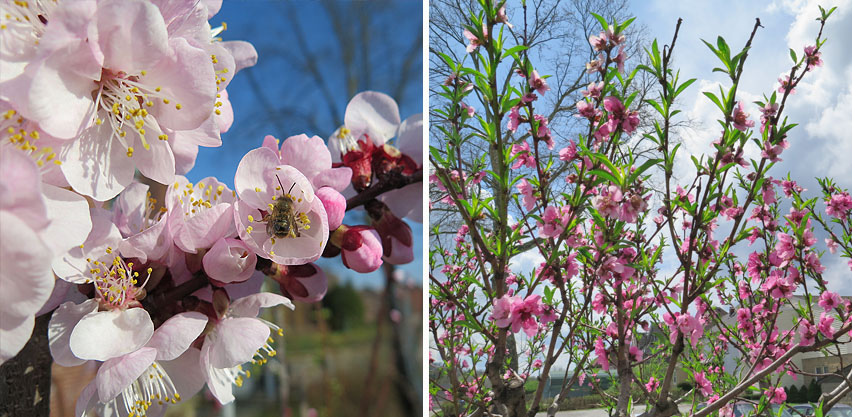
Early Spring blossoms on stone fruits like peaches support honey bees and other pollinators.
CARBON SEQUESTRATION: All plants sequester a certain amount of carbon. As they live and grow, they capture the carbon dioxide in our air and bind the carbon into their plant parts. Perennials, can establish massive root systems over time. These roots lock that carbon deep into our soil.
Trees in particular can amass large chunks of carbon, while also purifying the air. Incorporating fruit trees into your landscape is an environmentally friendly action. It might not single-handedly reverse climate change, but it's a step in the right direction!
Property Enhancement Through Trees
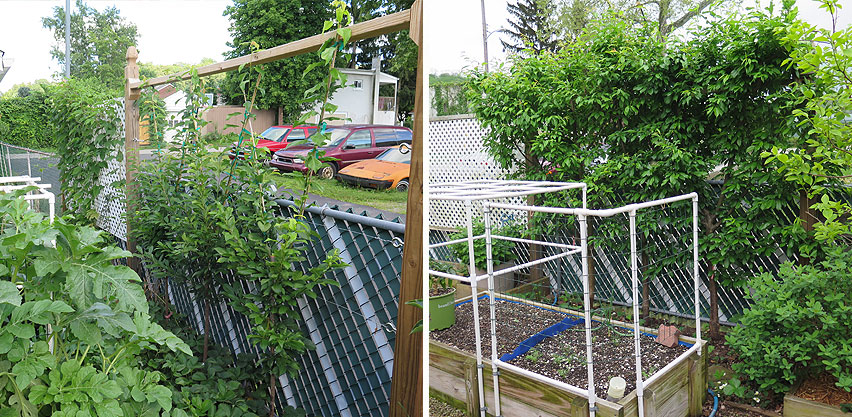
Training these plum trees in a fan shape, created a fast growing privacy fence.
FUNCTIONAL VALUE: Trees and shrubs serve several basic functions when placed appropriately on your lot. Perimeter placement can be used to create an element of privacy, offering seclusion in an urban or suburban setting. When trees are placed on the sunny side of a property, they provide shade during hot Summer months. This results in real monetary savings as cooling costs are reduced. Trees can also function as windbreaks. Such strategies yield a property that is more pleasant and inviting, despite urban and climatic challenges.
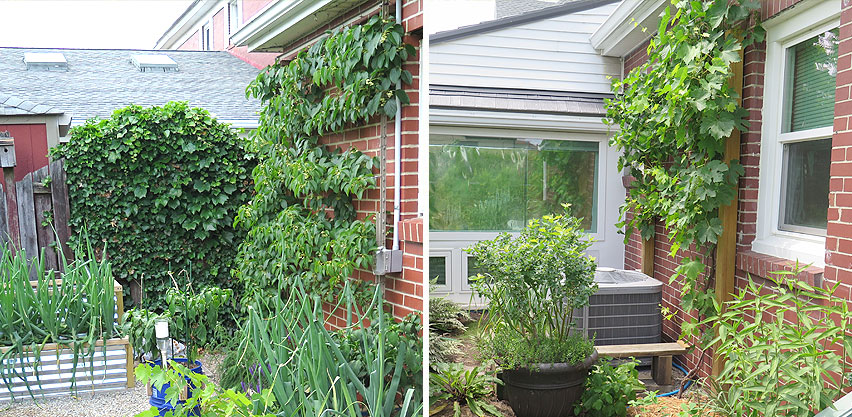
These kiwi & grape vines cover the south facing walls of this house which has a cooling effect during the Summer.
INCREASED PROPERTY VALUE: All of the functional values of trees can benefit you in the short term. But in the long run, what if you end up selling your home and moving? Is your investment lost? Well, most realtors observe that residential lots are appraised at a higher value when they have trees. Compared to a treeless lot, your property may sell for 10% more if your trees are mature and healthy. So that $30 tree might mean hundreds or thousands of dollars in profit later on!
How Plants Enhance the Soil
EROSION CONTROL: Due to erratic weather events and poor water management, many areas are losing top soil at alarming rates. Additionally, urban and suburban development has contributed to further soil erosion. Vegetation is a crucial tool for erosion control. This is often implemented through various grasses and ground covers. But trees are also highly useful in long term erosion strategies.
SOIL BUILDING: As a site begins to mature, trees serve a vital role in restoring and improving soil quality. Their roots establish relationships with mycorrhizal fungi and various micro-organisms. These systems naturally break down rock minerals in the soil through a process called mineralization. These nutrients are converted to an organic, absorbable form and drawn up by the trees. Then in the Autumn, deciduous leaves fall and enrich the surrounding soil.
NITROGEN FIXATION: Some plants also offer an additional enhancement to soils. Nitrogen fixers host bacteria that capture nitrogen from the air and store it in the soil as a plant usable form. There are many nitrogen fixing plants, including edibles such as Sea Berries (Sea Buckthorn) and Goumis.
Personal Benefits from Fruit Trees
Planting fruits trees and shrubs can make a lot of sense on an intellectual level. There are plenty of cold, hard facts that rationalize the investment. But there is a very personal element that we should never overlook.
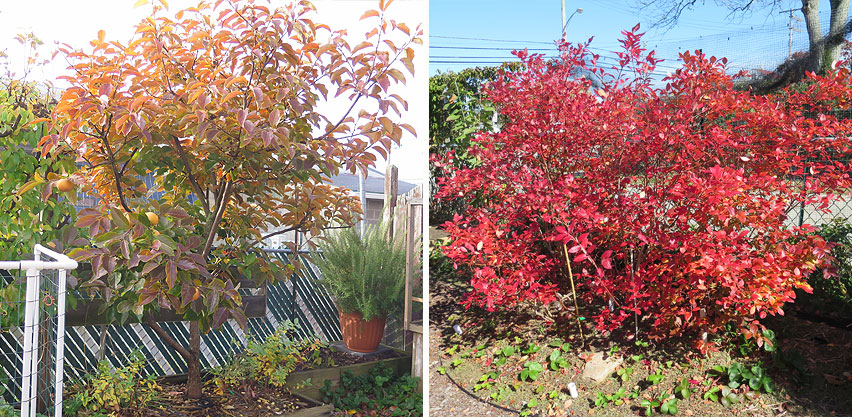
This Asian persimmon & these blueberries provide a beautiful splash of color in the Autumn.
AESTHETIC VALUE: Many edible trees, vines and shrubs simply look gorgeous when properly placed into your landscape. The twisted, gnarled branches of a contorted mulberry can make for a breathtaking centerpiece. The lush glossy leaves of a persimmon or jujube are very ornamental in appearance. Many fruiting trees produce lovely flowers in the Spring. Stone fruits like cherries, peaches and plums are great examples. The flowers of a maypop passiflora (passion fruit) offer amazing beauty while dropping delicious tropical tasting fruit!
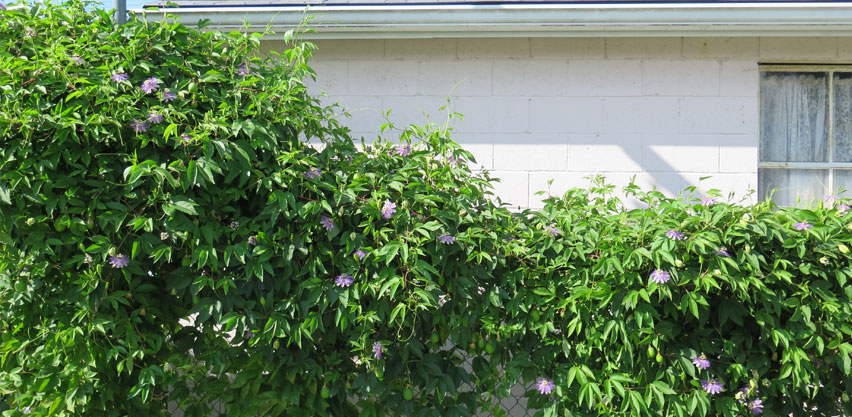
The vigorous growing passion fruit vine can be used to create a privacy screen along a property edge.
FOOD FOOD FOOD: The most outstanding reason for growing fruiting plants is the food. Indeed, it is so rewarding as you start bringing in your first harvest from your fruit tree! Eating tree-ripened fruit means a taste that is far superior to grocery produce.
A personal backyard orchard might mean new varieties of fruit that you can't find anywhere else. Paw paws are a good example of a fruit that is so delicious, but not viable for retail as a fresh fruit. If you want them, you need to grow them yourself! You can select fruits that are your favorite to eat, that are hardest to find or that have the highest nutritional benefits.
Once your system is established, you'll soon be saving money as you enjoy free produce that can be eaten on the spot or preserved for later consumption. This is money well spent, without a doubt!
Fruit Tree, Vine & Shrub Selection
Growing some fruit trees in your backyard does not have to be an overly complicated process. You could just go out and get a tree from your local nursery and be done with it. Some people though, like to research and do more extensive planning. From my own experience, I certainly wish I had considered additional factors before installing my plants. I'm glad I put them in. But still, there may be things we don't think about when we're first getting started. I want to share some perspectives that are worth consideration as you make your plans.

Passion fruit vines produce beautiful flowers & with the help of carpenter bees, they set delicious tropical tasting fruits!
How to Decide Which Fruiting Plants to Grow
There are several methods for choosing your fruit varieties. Everyone has different tastes and goals. Your backyard orchard should reflect you and your values.
BROADEN YOUR PALATE: There's a lot more out there than apples, peaches and grapes. Right now you might already know what you want to grow. But have you spent much time learning about the many uncommon fruits that could be grown in your area? In my temperate zone 6 climate, I was surprised to learn about jujubes, persimmons, hardy kiwi, maypop passiflora, Che, aronia, paw paw, goumi and many more.
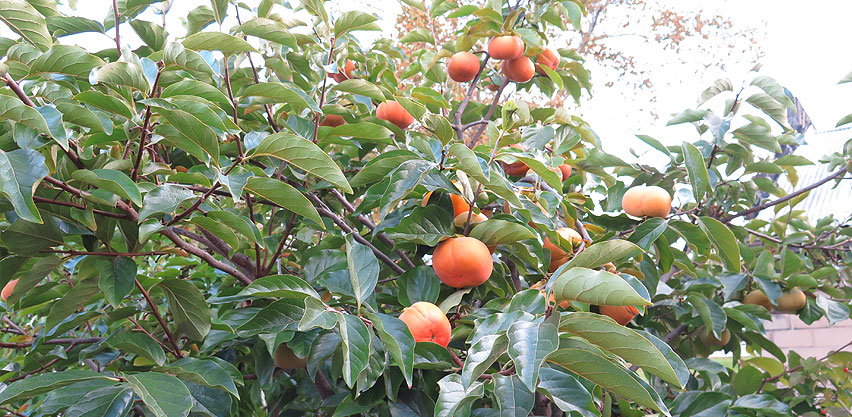
Asian persimmons have delicious non-astringent fruit which can be eaten when crunchy or after it has softened up.
Do you want to learn more? There are some really great sites that offer dozens and dozens of choices. I recommend signing up for their catalogs: Raintree Nursery, One Green World, Edible Landscaping and Bay Laurel Nursery. Also, a book that you should consider reading is "Grow Fruit Naturally" by Lee Reich.
RARITY & MONETARY VALUE: As you learn about new and exciting types of fruits, you might soon realize how rare some of them are. In my home of Western Pennsylvania a little known native fruit is the paw paw. Despite its indigenous nature, I personally had never eaten one until I was in my 30s. I first heard about paw paws from a fruit tree catalog. Afterwards, it took more than two years before I could get my hands on a small slither for tasting.
This taught me the foolishness of wasting my limited real estate on common apple trees. On my small (1/13th acre) lot, every square foot counts. If I had more space, it would have been fine. But it might be worth growing things that you can't buy cheaply at a local grocery store. Some fruits are rather expensive per pound. Why not grow some of those varieties?
NUTRIENT DENSITY: Are you interested in growing your own food so that you can enjoy improved health? Many fruits have been touted as "superfoods" due to their rich antioxidant content. It might be easy to purchase enough calories for a healthy diet. But supplementing our meals with nutrient-dense fruits and veggies is an excellent idea.
So why not grow some of the most nutrient dense fruits and berries? If you are limited on space, this strategy can yield the highest return for your investment. Consider blueberries. Or better yet, aronia and sea berries. Goumis are a good candidate as well. Each of these offer various levels of Vitamin C, lycopene, anthocyanins and more!
General Planting Prerequisites
At this point, you might have compiled a lengthy list of fruit candidates. Perhaps it's more than you can fit on your lot. Let's look at the basic growing factors that may eliminate a few of those prospects.
POLLINATION REQUIREMENTS: Some fruit varieties are self-pollinating. In this case, you only need a single type of that fruit in order to achieve good fruit set. Other trees and shrubs might be dioecious, requiring special pollinators. For example, most kiwis require a male vine, in addition to the fruiting female vines. Sea berries also need a male pollinator. This increases your space requirements as you must include this additional plant. Finally, there are some varieties that are "partially self-fertile". They will produce a partial crop even with just a single plant. But they may bear larger crops with a second variety.
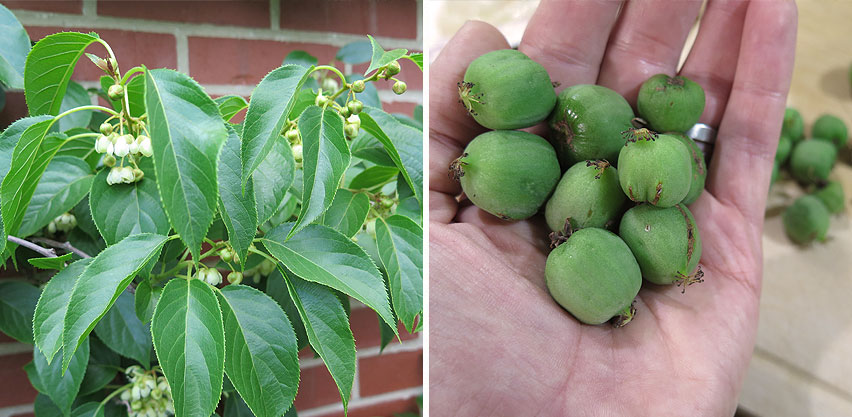
"Issai" hardy kiwi (Actinidia arguta) has self-pollinating flowers that make berries with just a single vine.
Even within a certain plant family, you might find variance. For example, the Issai hardy kiwi is famous for not requiring a male plant to set fruit. Read the descriptions closely for any variety you are considering. An interesting "hack" is to grow a multi-grafted tree. Some nurseries sell fruit trees that have multiple scion types on a single trunk. These may be cross-pollinating selections that eliminate the need for two individual plants!
ZONE HARDINESS: Zone hardiness is the easiest way to eliminate a large swath of fruiting options. It is imperative that you identify the growing zone for where you live. The USDA Plant Hardiness Zone Map is used as a guide to estimate the coldest that it might get in the area where you reside. Different plants can withstand varying levels of cold. Tropical plants simply won't survive the harsh Winters of a cold temperate climate. So if you live in Vermont, you can quickly eliminate plants like Citrus, Bananas or Olives.
You can try to push the envelope. You might grow a plant that is rated for Zone 7, even though you live in Zone 6. Mulching the plant will help out. In particular, you could plant it in a warm micro climate. A sheltered spot on your lot might protect the plant just enough to sustain it during those coldest nights. An obvious work around is to grow your Mediterranean, tropical and sub-tropical plants in large pots. Then these can be brought inside during the Winter months.
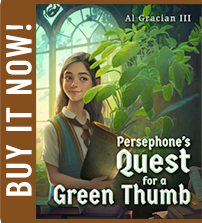
![I'd Rather Be Planting Trees [Gardening T-Shirt Design] I'd Rather Be Planting Trees [Gardening T-Shirt Design]](images/I'd-Rather-Be-Planting-Trees_Gardening-Tshirt-Spreadshirt.jpg)
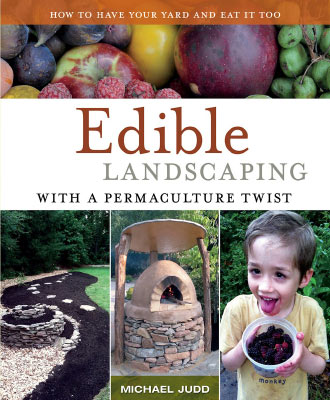
![Pre-Industrial Revolution CLIMATE CONTROL [Gardening T-Shirt Design] Pre-Industrial Revolution CLIMATE CONTROL [Gardening T-Shirt Design]](images/Pre-Industrial-Revolution-CLIMATE-CONTROL-carbon-sequestering_Gardening-Tshirt-Spreadshirt.jpg)